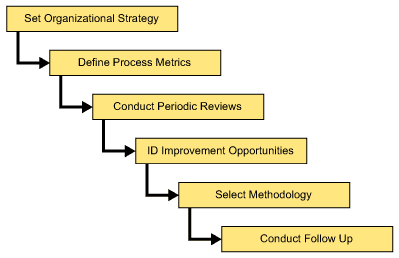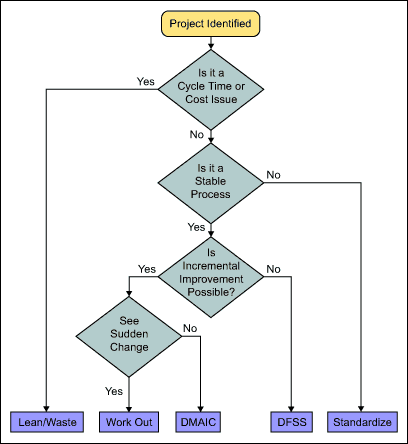
When a company decides to deploy a strategic initiative, whether the approach is called Six Sigma or something else, it must stay focused on the primary objective – making improvements and then sustaining the gains. To ensure the program’s success, the organization must design the initiative to take into account its people, history and culture. And most importantly, the approach must be systematic.
Here is a six-step approach that has consistently achieved results:

1. Look at the Organization Strategically and Develop Business Objectives
- Identify and understand customer needs.
- Identify and understand business needs.
- Identify and understand employee needs.
- Identify business processes.
Make certain there is a common understanding of the short- and long-term goals of the organization. To accomplish this, a comprehensive study of customer wants and needs must be undertaken. An analysis of the business and employee needs also should be done. Once all these needs are clarified, they must be matched to ensure that they are in alignment. Any discrepancies have to be resolved. Some companies hired outside firms to conduct the surveys and compile the results; others use internal resources.
Next, it is critical to identify the core processes of the organization. These are the dominant processes by which the business operates. For example, a typical business process map starts with product development, followed by marketing, sales, operations and then customer service. Each of these processes is critical to achieve the business results. However, certain processes are linked to only some of the customer needs. Increasing market share is more likely to be accomplished via product development and sales than customer service.
In all probability, these core processes will be a high-level representation of the business. It will be necessary, however, to go further and complete a detailed definition of the lower-level processes. This is the beginning of process management.
Process management identifies the core processes and sub-processes in the organization, and determines who the customers are and the requirements of those customers. Once those requirements are known, measurements can be put into place to understand how well the organization is meeting the requirements. These measurements become the foundation of a dashboard system.
2. Translate Business Objectives into Process Metrics
- Link the needs to the processes.
- Establish metrics.
- Set goals for the metrics to drive the desired business results.
The dashboard system is the link between the strategic objectives and process metrics. As in automobiles, dashboards provide, at a glance, the state of company operations and early-warning flags of potential problems. Thus, management can use dashboard indicators to see how the company is doing and when to take action designed to improve the business.
Dashboards also are the measures by which company owners or shareholders determine if senior management is achieving the organization’s goals.
Just implementing process management, and nothing else, will have a positive impact on business results. It allows everyone in the organization to understand what they are being measured against and, most importantly, how this helps the organization achieve its top objectives.
Next, the company must understand what level of performance these metrics should reach in order to achieve the desired business objectives. From an operations perspective, cycle time metrics usually impact customer satisfaction, but what should the cycle time be to truly delight the customers? This is the goal-setting process. The customer intelligence gained from the first step should be utilized to set these targets. Setting targets also will drive behavior(s) in the organization.
3. Conduct Periodic Process Reviews
- Monitor process performance.
- Perform gap analysis.
The results of process metrics should be reviewed frequently. How frequently depends on many factors, such as criticality to the customer, natural cycles of the process, etc. Such reviews should focus on accessing which metrics are performing well, and which metrics have less than the desired results. The company must explore the reasons why those not meeting the targets are failing. These results should indicate where there are opportunities for improvement.
4. Identify Improvement Opportunities
- Identify critical improvement opportunities.
- Prioritize improvement opportunities.
This is where leadership takes ownership of the process. Senior management needs to identify where to focus the efforts. Are there areas where there is significant bleeding? Are there areas where long-term, sustainable improvements will get the company to its goals? Are there areas where the company needs to be faster or more reliable? Does the company need new products or new technology? As in all companies, resources are at a premium and all opportunities cannot be acted upon. The business leadership must understand how to prioritize the opportunity and assess the appropriate resource needs. This means making the tough decisions. The criteria for prioritization must fit the strategy of the company and the given situation.
5. Select Methodology to Achieve Results
- Determine deficiency.
- Evaluate appropriate method.
- Assign resources.
- Conduct project progress reviews.
- Implement process change(s).
- Project financial impact.
Selected the improvement opportunities or projects that match the strategy involves committing resources. Senior management must understand that running the business requires using several different tools, knowing which tools work best (so they help identify the best methodology to use) and choosing the tools that best fits the situation. The flow chart in Figure 2 shows the decision-making that leadership should use to identify the best way to commit resources.

A stable process will allow the next decision to be made: Will incremental improvement suffice. In other words, what magnitude of improvement is needed to meet the desired outcome? Extensive improvement efforts require special tools included in the Design for Six Sigma (DFSS) method. Some reasons for using DFSS include – the current process cannot be improved enough (equipment or technology limitations), a competitive disadvantage exists, incremental improvement will not gain the competitive advantage, and the strategic initiative warrants the action.
Once a project has been identified, based on the gap analysis, leadership should be able to determine which tool to use by following the flow chart and asking questions at each decision point. If the problem deals with cycle time or a cost issue, it is likely that Lean, or waste reduction methods, are appropriate. If the problem is not a cycle time or cost issue, it needs to be determined if the process is stable before going to the next step. A stable process is defined as one that generates routine process data predictably over time. If the process is not considered stable, standardize the process as the first step towards stability.
If incremental improvement is acceptable, a follow-up question is necessary: Has the process shifted dramatically? A sudden shift in process performance necessitates an immediate response and the Work-Out approach is best suited for this. The DMAIC methodology is designed for longer-term reduction in process variation.
Once the project(s) is launched, ongoing progress reviews should be conducted. These reviews should be conducted as tollgates of the project (i.e., leadership concurs with moving forward at key milestones). These reviews should ultimately include approval of changes to the process, implementation plans for the changes and a financial impact analysis based on the changes.
It also is important to remember that the ultimate objective is to improve the process and to make sure that the improvement is maintained. As a result, it is critical to document all process changes and to make sure all processes comply with accepted process management/configuration practices. Finally, changes to process do not just happen; implementation plans, including training, must be integrated as part of all improvement efforts.
6. Follow-Up on Improvements
- Ensure that improvement is realized.
- Confirm financial impact.
Once changes have been implemented, care must be taken to ensure that the process does not revert back to a previous state. Careful monitoring of the process and process metrics is required. Another key component of follow-up is to confirm the financial impact. This should be done and verified through the finance function of the organization. This financial result will translate to the bottom line, and give credibility to the effort.
Conclusion: What to Do Now
So the question could still be asked by the business leader, “What do I do now?” The basic answer is: Do not try to be another company. Study the companies in the same industry that are considered the “best in class” or which perform similar processes, and learn from them. Business leaders should pick those strategies or elements of a strategy that will work in their organization and internalize them. But feel free to merge strategies into something that is a unique creation and that will be effective for a particular organization.
A company must be careful not to exclude things that it has utilized effectively. For example, GE used Work-Out very effectively prior to implementing a Six Sigma initiative. The belief by many of the leaders was that Work-out was how the company used to do things. In reality, Work-out was subsequently brought back into favor and integrated as part of Six Sigma.
So the message is twofold. First, companies should adopt an organization-wide strategy to drive improvement in all areas of the company. This should be the foremost desire of the leadership. Second, companies should build their own improvement strategy utilizing the best of the tools/methods available, as well as new tools based on the creativity of their own management and staff.